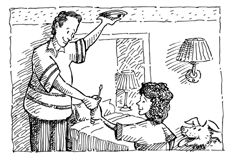 A $10 investment can save your family's lives. That's the cost of a simple, battery-operated smoke alarm. It's a small price to pay for safety and peace of mind.
A $10 investment can save your family's lives. That's the cost of a simple, battery-operated smoke alarm. It's a small price to pay for safety and peace of mind.
Most fire deaths occur at night when people are asleep, according to the National Fire Protection Association (NFPA). Contrary to popular belief, the smell of smoke may not wake a sleeping person. Instead, the poisonous gases and smoke produced by a fire can numb the senses and put one into a deeper sleep.
A working smoke alarm can make the difference between life and death.
- Install smoke alarms outside each sleeping area and on each level of your home.
- Also install alarms inside bedrooms if people sleep with doors closed.
- Test monthly. Replace all batteries at least once a year (such as when you set your clocks forward or back) or when the alarm alerts you the battery power is low. Replace the batteries immediately if you move into a new home.
- Vacuum away cobwebs and dust regularly.
- Write the date of installation inside the cover. Smoke alarms become less sensitive over time so replace every ten years.
- Buy only those alarms that bear the mark of an independent testing laboratory.
- Consider installing an automatic fire sprinkler system when you renovate your home.
Also, keep at least one multi-purpose fire extinguisher in your home and learn how to use it. Plan fire escape routes and practice your escape plan at least twice a year with your family. Coach young children not to hide from smoke or fire and to trust firefighters. Teach kids about crawling underneath smoke to escape a fire and how to "stop, drop and roll." Young children should know their street address, last name and how to dial 911.
-Tips from the American Red Cross (redcross.org/services/disaster/beprepared) and the NFPA (nfpa.org/education)
Test your smoke detectors monthly
Nine out of 10 homes now have smoke detectors but too many of them don't work. Make sure your home has at least one detector for each floor and test them monthly.













